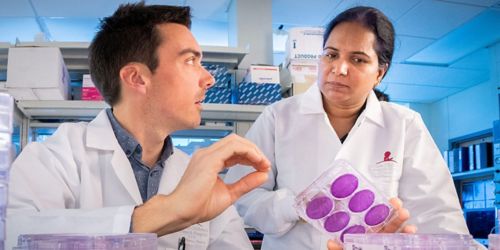St. Jude Family of Websites
Explore our cutting edge research, world-class patient care, career opportunities and more.
St. Jude Children's Research Hospital Home

- Fundraising
St. Jude Family of Websites
Explore our cutting edge research, world-class patient care, career opportunities and more.
St. Jude Children's Research Hospital Home

- Fundraising
Innate immunity: the body’s first line of defense against a dangerous fungus

Benoit Briard, PhD, left, and Thirumala Kanneganti, PhD, recently explored the mechanism of innate immunity.
Our laboratory explores the machinery of innate immunity, the body’s first defensive front against a wide range of invaders, including viruses, bacteria, fungi and parasites. Our longtime interest in particular is how the immune system detects these pathogens. What are the sensors of the innate immune system and what do they sense? Somehow, we’ve inherited the genes that code the innate immune system to enable it to detect these invaders.
Our latest research explores the sensors for a very common fungus, Aspergillus fumigatus, which is found in the soil. For people with healthy immune systems, inhaling the spores of this fungus is not a problem. Our innate immune system can sense and attack them. However, for people with compromised immune systems—most notably children undergoing cancer chemotherapy—the fungus can be very dangerous, even deadly. It can overcome the weakened immune system and grow without attracting the white blood cells, called neutrophils, that are the innate immune system’s defense against invaders.
Normally, such invaders as Aspergillus activate a system called the inflammasome, a defensive machine comprised of proteins. This inflammasome, in essence, makes a judgment to kill the invading fungal cells the innate immune system detects.
One-two punch of innate immunity
To explore this mechanism, as reported in our latest research paper, first author Benoit Briard in our laboratory genetically engineered some twenty strains of so-called “knockout” models lacking one or another of the innate immune system sensors and analyzed the effects on Aspergillus resistance. His experiments revealed a “one-two punch” by the innate immune system against the fungus — two distinct pathways by which Aspergillus infection controls inflammasome activation. One pathway leads to production of a protein called IRGB10, which attacks the cell wall of the fungus. In a second pathway, a molecule called beta glucan, a component of the fungal cell wall, directly triggers assembly of the inflammasome machinery.
This finding was quite a surprise for us. I had previously believed that the activating machinery would involve a simple molecular pathway. But we found that up to 10 signaling molecules are involved in the immune response.
New insights into innate immunity
Benoit’s work has paid off in significant new insights into not only Aspergillus infection, but the innate immune system in general. He has demonstrated a highly effective and comprehensive research approach to dissecting the complex pathways of the innate immune system. And, our findings provide an excellent example of how the innate immune system tailors a unique, pathogen-specific response using common regulator or effector proteins.
Our research also has important clinical implications for protecting patients against fungal infections, such as children undergoing chemotherapy. Once we understand the machinery by which the innate immune system senses the fungus, we can work to develop drugs that activate the genes that produce those sensors. And conversely, we can develop drugs that inhibit genes that suppress production of the sensors.
This work has opened up important new research pathways for us. For example, we believe that there are many more receptors for sensing Aspergillus, and if we can identify those, we will have still more potential drug targets.






